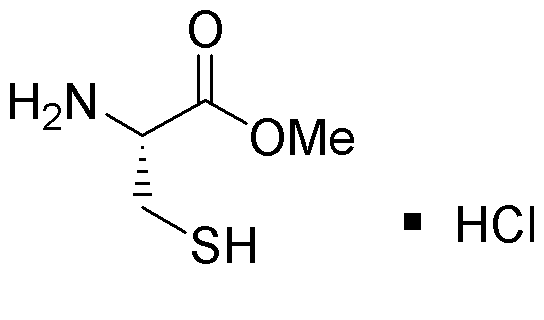L-Cysteine methyl ester hydrochloride is widely utilized in research focused on:
- Biochemical Research: This compound serves as a vital precursor in the synthesis of various peptides and proteins, aiding researchers in studying protein structure and function.
- Pharmaceutical Development: It is often used in drug formulation processes, particularly in the development of antioxidants and anti-aging products, benefiting the cosmetics and pharmaceutical industries.
- Cell Culture Applications: L-Cysteine methyl ester hydrochloride is essential in cell culture media, enhancing cell growth and viability, which is crucial for biotechnological applications.
- Antioxidant Studies: Researchers utilize this compound to investigate its potential as an antioxidant, helping to understand its role in reducing oxidative stress in various biological systems.
- Food Industry: It finds application as a flavor enhancer and preservative, improving the shelf life and taste of food products, thus benefiting food manufacturers.
General Information
Properties
Safety and Regulations
Applications
L-Cysteine methyl ester hydrochloride is widely utilized in research focused on:
- Biochemical Research: This compound serves as a vital precursor in the synthesis of various peptides and proteins, aiding researchers in studying protein structure and function.
- Pharmaceutical Development: It is often used in drug formulation processes, particularly in the development of antioxidants and anti-aging products, benefiting the cosmetics and pharmaceutical industries.
- Cell Culture Applications: L-Cysteine methyl ester hydrochloride is essential in cell culture media, enhancing cell growth and viability, which is crucial for biotechnological applications.
- Antioxidant Studies: Researchers utilize this compound to investigate its potential as an antioxidant, helping to understand its role in reducing oxidative stress in various biological systems.
- Food Industry: It finds application as a flavor enhancer and preservative, improving the shelf life and taste of food products, thus benefiting food manufacturers.
Documents
Safety Data Sheets (SDS)
The SDS provides comprehensive safety information on handling, storage, and disposal of the product.
Product Specification (PS)
The PS provides a comprehensive breakdown of the product’s properties, including chemical composition, physical state, purity, and storage requirements. It also details acceptable quality ranges and the product's intended applications.
Certificates of Analysis (COA)
Search for Certificates of Analysis (COA) by entering the products Lot Number. Lot and Batch Numbers can be found on a product’s label following the words ‘Lot’ or ‘Batch’.
*Catalog Number
*Lot Number
Certificates Of Origin (COO)
This COO confirms the country where the product was manufactured, and also details the materials and components used in it and whether it is derived from natural, synthetic, or other specific sources. This certificate may be required for customs, trade, and regulatory compliance.
*Catalog Number
*Lot Number
Safety Data Sheets (SDS)
The SDS provides comprehensive safety information on handling, storage, and disposal of the product.
DownloadProduct Specification (PS)
The PS provides a comprehensive breakdown of the product’s properties, including chemical composition, physical state, purity, and storage requirements. It also details acceptable quality ranges and the product's intended applications.
DownloadCertificates of Analysis (COA)
Search for Certificates of Analysis (COA) by entering the products Lot Number. Lot and Batch Numbers can be found on a product’s label following the words ‘Lot’ or ‘Batch’.
*Catalog Number
*Lot Number
Certificates Of Origin (COO)
This COO confirms the country where the product was manufactured, and also details the materials and components used in it and whether it is derived from natural, synthetic, or other specific sources. This certificate may be required for customs, trade, and regulatory compliance.


